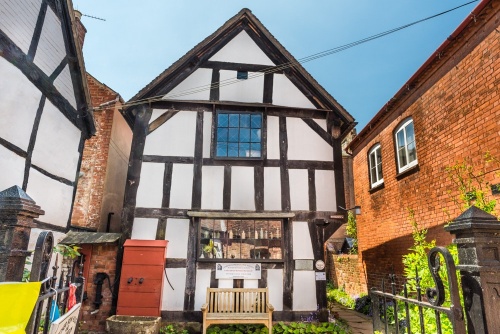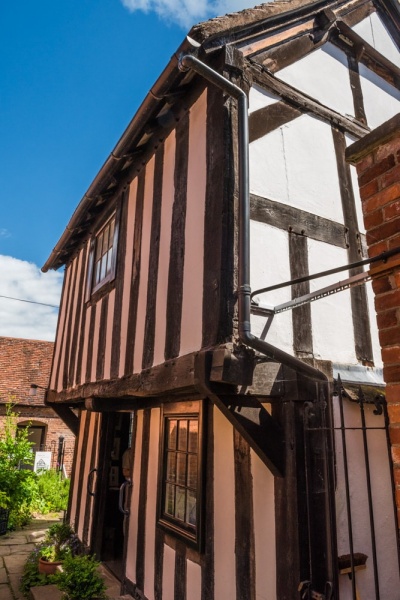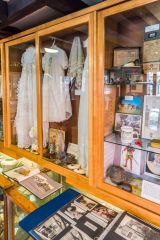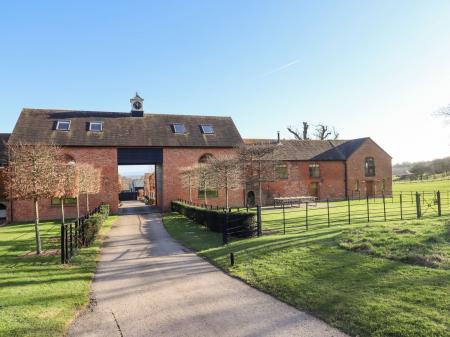
From the name, we can assume that at least some of the buildings were butcher's shops.
All 15 cottages and shops were demolished in 1830 to make way for new development. This cottage, however, was not destroyed but rather was disassembled, then reassembled in the back garden of a house on High Street. There it stood until 1979 when the entire building was re-erected on its current site opposite the Ledbury Heritage Centre.

What is a burgage house?
The term 'burgage' comes from the same root as borough and burgh. Burgage houses were owned by the king or by an important lord and rented out to create a steady income. They usually occupied long, narrow strips of land with a narrow street frontage. Rent was usually in the form of money, unlike rural tenures where the rent was usually in the form of services.
The Butchers Row House Museum offers free entry and contains exhibits on life in Ledbury during the Victorian period. There are old photos, mileposts, pots, pans and kitchen tools, lamps, merchant's signs, traditional smocks, toys, clothing, letters, old documents, clay pipes ... in short, a fascinating collection revealing what daily life was like in Ledbury over the centuries.

There is a small exhibit of finds from the 1645 Civil War Battle of Ledbury, including breastplates and helmets. There is also a fascinating collection of musical instruments including a Tibetan pipe made from a thigh bone and a traditional hurdy-gurdy.
Perhaps the most fascinating musical instrument is the Ledbury Lute, made in London by Joseph Buchinger between 1785-1811. This peculiar hybrid instrument has a body like a French Arch Cittern but the peg box, neck, bridge and strings are those of an English Harp-Lute-Guitar.

Clissett Chairs
One exhibit upstairs covers the life and career of local chair maker Philip Clissett (1817-1913). Clissett was a native of Birtsmorton in Worcestershire but moved to Bosbury in 1840 where he established himself as a chairmaker.
For the next 40 years, he established a reputation for his traditional chairs made with ash and elm from a local estate. It would take Clissett a full day to make a chair, which he would then take in a donkey cart to Ledbury or Hereford to sell.
He got his big break in the 1880s when architect James MacLaren was designing a new wing for Ledbury Park and commissioned him to make an elongated 'ladderback' style of chair. More commissions followed and the Arts and Crafts pioneer Ernest Gimson came to study under Clissett. Gimson helped popularise the 'Clissett Chair', which is still being made today using traditional tools and techniques.
Several examples of Clissett chairs and stools are on display on the first floor.

Taking centre stage (literally) in the first-floor room is a slipper bath, an iron bathtub in the shape of a giant slipper.
A plaque on the cottage exterior commemorates the cottage's history in these words:
'Butcher Row House - 16th century.
Originally part of a row running down the middle of High Street that was demolished circa 1830. The building was re-erected then in a back yard in High Street and moved to this site in 1979 by the Ledbury and District Society'.
The Butcher's Row House Museum is a delightful local heritage museum housed in a picturesque timber-framed cottage. In this case, the museum building is just as interesting as the museum exhibitions, and both are well worth taking the time to enjoy. The museum is located halfway up Church Lane from the High Street.









 We've 'tagged' this attraction information to help you find related historic attractions and learn more about major time periods mentioned.
We've 'tagged' this attraction information to help you find related historic attractions and learn more about major time periods mentioned.



